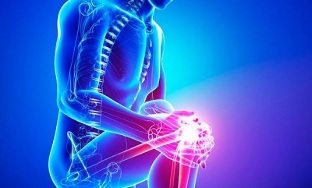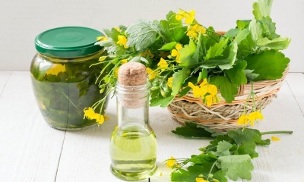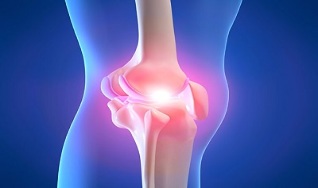Thousands of people, especially after fifty years, suffer from various forms of musculoskeletal disorders. This has a significant impact on the quality of life, leads to numerous restrictions and causes considerable pain.
Osteoarthritis of the knee joint, also known as osteoarthritis of the knee, is rightly considered one of the leading representatives on the list of the most common causes of disability in the adult population of Russia. However, do not believe that you are not at risk of this disease at a young age: you can leave the doctor's office long before retirement with a record of "knee osteoarthritis of the knee" on the card.
Concept and causes of knee osteoarthritis
Osteoarthritis is nothing more than destructive changes in cartilage tissue, that is, its destruction, exhaustion, accompanied by a decrease in the volume of synovial fluid.
This can have various reasons:
- Postponed injuries and constant stress on the joints, strenuous physical work;
- Hereditary factors;
- metabolic disorders;
- overweight;
- Poor diet, lack of essential vitamins and minerals.
Stages of osteoarthritis of the knee joint
Doctors differentiate between three stages of osteoarthritis of the knee joint:
- The signs of the first stage are short-term pain that occurs after exertion and goes away quickly enough at rest. The pain is dull and aching. Outwardly, the joint looks healthy. The only thing that can be noticed at this stage is a slight swelling.
- In the second stage, the pain syndrome is characterized by greater severity and duration. Patients notice a certain stiffness of the joint in the morning, a crunch when moving in the knee. A certain restriction of movement is possible, the joint increases in volume;
- In the third stage there is a significant limitation of mobility, constant severe pain and severe deformation of the joint.
Unfortunately almost nobody sounds the alarm at the first signs of illness. As a result, people with advanced osteoarthritis come to specialists when much more complex treatment is required.

Osteoarthritis of the knee with delayed diagnosis and insufficient therapy can have very serious consequences, including complete immobility of the affected leg, if movement in space without a crutch becomes completely impossible.
In the most advanced cases, the only way out is an operation in which an artificial joint is implanted.
These operations are complex, expensive, and can be complicated.
That is why it is so important not to ignore knee pain and not delay your visit to the doctor.
Treatment of osteoarthritis of the knee joint with alternative methods
To overcome osteoarthritis of the knee, complex therapy is important: a combination of means prescribed by a specialist with folk remedies for osteoarthritis of the knee joints.
Traditional methods of treating osteoarthritis of the knee joint show quite good effects, especially in the initial stages of the development of the disease. Their use will at least relieve the pain and maximally allow you not to bring the matter to expensive operations.
Also, one should not lose sight of the fact that this disease is chronic and therefore requires constant attention. Modern experts attribute osteoarthritis of the knee to incurable progressive diseases.
Accordingly, most of the treatment consists of taking certain drugs continuously to relieve pain and reduce the inflammatory process. However, taking medication for long periods of time without interruption is harmful. That is why it is so important for people with osteoarthritis of the knee to be able to use folk methods at least during periods of remission.
So let's find out what the alternative treatment for osteoarthritis of the knee joint is. The experience of fighting this disease goes back hundreds of years, so the list of remedies that can be used at home is very extensive. For convenience, all folk remedies for the treatment of osteoarthritis of the knee joint can be divided into four groups.
Medicinal herbs

The first group includes medicinal herbs: burdock, onion, celandine, cabbage leaves, etc. Herbal treatment for osteoarthritis of the knee joint involves the use of self-prepared medication both internally and externally.
- Compresses made from fresh horseradish roots, cabbage or burdock leaves, which have to be applied to a painful knee, isolated with cotton wool or several layers of bandage and left on overnight, bring noticeable relief. Previously, cabbage leaves were wrinkled or beaten for greater effect, causing them to release juice. You can lightly grease the leaves with honey. Burdock leaves are dipped in boiling water for 30 seconds and then cooled. Horseradish root is chopped and slightly warmed;
- You can also use celandine: a few tablespoons of dried herbs should be boiled with boiling water and then cooled to 40-50 ° C. The resulting infusion is drunk before meals, and the remaining brewed celandine is applied as a compress.
- If the disease is in its early stages, ice healing can be used. The ice pack is firmly attached to the sore spot with a woolen cloth and remains there until the ice melts. This compress is used when you need to quickly get rid of edema and stop the inflammatory process.
- Compresses take a lot of time, so for many people a different rubbing is more convenient. Rubbing is a liquid mixture of remedies that needs to be rubbed vigorously into the skin of the affected area. For the treatment of osteoarthritis, rubbing the root of Elecampane, matured with vodka, tincture of chamomile, tincture of yellow dandelion heads and sunflower oil are particularly suitable. It is better to apply them to clean, ideally steamed skin. It is necessary to rub the sore knee for 5-10 minutes a day, and then wrap it with a towel or warm cloth for a while.
- Another proven recipe is the saber tincture, for the preparation of which 1-1. 5 tablespoons of herbs are poured into 100 ml of vodka and left in place. The knee is treated with the resulting tincture twice a day for a month.
- There is a recipe based on potato sprouts. They are washed, placed in a glass container, poured with vodka and left out of the reach of light for three weeks. After this time, the infusion is filtered and the sprouts used are discarded;
- You can also peel and chop the garlic, pour 200 ml of vegetable oil over it and leave in a dark place for a week. The tincture has a strong smell, this must be taken into account if you need to go somewhere shortly after application. In this case, you should thoroughly wash the places where the tincture penetrated.
- Many people notice the benefits of baths based on medicinal herbs: malt, senna herb, and others. A pine bath works well. You can either buy a ready-made collection of conifers at a pharmacy or make a brew yourself. To do this, you need to take young coniferous branches with a total volume of about one liter, pour two or three liters of water and boil for about 10 minutes. Then the broth is filtered, the twigs are thrown away, and the liquid is poured into a water bath. You should bathe with medicinal herbs for 15 minutes.
The simplest is the salt bath. Three tablespoons of ordinary or sea salt and the same amount of baking soda are poured into a basin with hot water, after which the sore knee is immersed in the basin for 15 minutes.
After bathing, the feet should be dried quickly and hidden under a warm cloth.
Infusions you prepare yourself are taken internally. They do not need to be boiled, the dried herbs are simply poured over with boiling water and kept to cool. Infusions are taken 2-3 times a day, half a glass each time. For the treatment of knee osteoarthritis, infusions are made from horsetail, juniper, young nettle and birch leaves.
With pain, a healing infusion of onions is very effective: two medium-sized onions are poured with a liter of boiling water and insisted that the resulting liquid be consumed in three doses.

Another simple yet effective recipe is cranberry tea. Pour a tablespoon of fresh or dried cranberry leaves with a glass of boiling water.
Like most infusions, this tea should be drunk half a glass twice a day for a month, preferably in the afternoon.
The use of these decoctions helps restore metabolic processes in the affected cartilage tissues, reduce pain syndrome and promote the removal of harmful compounds from synovial fluid.
Self-massage
The second popular folk remedy for osteoarthritis of the knee joint is self-massage techniques. Self-massage is very effective, but it does not cost anything except for a temporary one. Please note that the knee must be prepared before the session! It's best to warm it up under a warm shower or light circular rubbing.
Then you can go straight to the massage.
Its main techniques are as follows:
- Circular lines with the palm of your hand. We alternate the lungs without pressing, stroking clockwise and against, while affecting not only the knee itself, but also the adjacent areas. This technique reduces muscle tone and improves blood and lymph flow from the area affected by osteoarthritis.
- rubbing. We rub the knee in a circle, applying noticeable pressure. Can be rubbed with the palm of your hand or with a folded fist. This relaxes the muscles and improves the mobility of the joint. Circular movements are most effective in a Turkish pose when the state of the knees allows this position;
- knee knee with fingertips with moderate pressure. This technique allows you to create a deeper effect on deeper structures.

Self-massage can be done by taking a bath at a comfortable temperature. Some sources mention honey massage at night, but a cream or special ointment is usually used. You can make such an ointment yourself.
To do this, a small amount of an essential oil with petroleum jelly must be added to the container. Rosemary oil has a positive effect on blood circulation, peppermint oil has a cooling and analgesic effect and lavender oil has an anti-inflammatory effect.
The duration of the self-massage is approx. 15 minutes and can be performed two to four times a day. Only a self-massage performed regularly is effective. In addition, massage is useful as a preventive measure. In this case, it is enough to do them at least once a week.
You should not feel any pain or discomfort during the self-massage, otherwise you can only worsen the situation.
Remedial gymnastics
The third remedy is therapeutic gymnastics. It also requires preliminary preparation, warming up, which can be used as a self-massage. Such a complex use of these two funds has a positive effect on their effectiveness.
Here are three simple exercises:
- Sit on a table or high chair with your feet off the floor. Then just swing your legs from side to side, the turns shouldn't be sharp and the range of motion is too large. The duration of the exercise is approximately seven minutes;
- Sit in a comfortable chair with your knees bent at right angles and your feet straight on the floor. The exercise can be done with only one affected leg. However, it is useful to use both legs not only when both knees are affected, but also for preventative purposes. Put your foot on your toes, lift your heel as high off the floor as possible, then lower it to the floor, and repeat this movement at a steady pace for five minutes. Can be performed alternately or simultaneously with two legs;
- Take the same posture as in the previous position, just resting on your heel. Hit the floor lightly with your toes. The duration of the exercise is five minutes.
Some exercises can be done in bed early in the morning. They are kind of an exercise for the joints. One such exercise is the bicycle exercise.
Another exercise is done as follows: bend one leg and keep the other straight, pull the toes of the outstretched leg toward you as far as possible, and then switch legs. Repeat several times. You can also alternately pull and straighten your legs to your chest.
Performance adjustment
The fourth way to treat osteoarthritis of the knee at home is considered to be diet adjustment. It is not enough to influence the body from the outside, it is necessary to make up for the lack of substances needed to restore the structure of cartilage cells.
So you need to make changes to the usual menu: add some products and exclude some or reduce their use to a minimum.
The subject of nutrition is particularly relevant for overweight people, as extra pounds in osteoarthritis of the knee worsen the already poor condition of the joint structures.
Let's start with a list of recommended products:

- Dairy products: cheese, cottage cheese, sour cream, kefir with a fat content of no more than 3. 2%. They contain many proteins that are useful in restoring cartilage tissue;
- Millet, rice and buckwheat porridge, whole grain bread. These foods are rich in complex carbohydrates, without which synovial fluid synthesis is impossible. You shouldn't buy instant porridge. They are not useful, since grain is processed for them very differently than when cooking porridge at home, which destroys most of the useful elements.
- Dishes containing gelatin: jellied fish, jellied meat, jelly, pudding. Gelatin restores cartilage cells due to its high collagen and chondroitin content.
- All fruits and vegetables, as they are rich in fiber. Vegetables, carrots, beans, celery, radishes, and cauliflower are especially useful.
- Steamed or steamed meat and fish, especially in combination with vegetables;
- germinated wheat;
- Nuts: hazelnuts, pine nuts and almonds.
So that healthy food can be better absorbed, it is recommended to drink two glasses of mineral water a day.
Let's move on to the list of harmful products:
- Salt and spices. They cannot be eliminated from the diet entirely. However, in order to combat joint diseases, it is worth limiting their use. This rule does not apply to turmeric: on the contrary, its use is considered beneficial. Turmeric has been shown to have a beneficial effect on cartilage tissue, which helps it grow and recover.
- Greasy, smoked and pickled dishes;
- semi-finished products;
- fast food and carbonated drinks;
- Alcoholic beverages: Even a low alcohol content slows down the metabolism, which has a negative effect on the regeneration process.
- Sweets and flour products. They're loaded with simple carbohydrates that can trigger weight gain. As mentioned above, extra pounds put extra strain on joints that are already weakened by osteoarthritis.
- coffee. This drink can be consumed, but only in small quantities, otherwise calcium will be washed out of the body.
- pepper, cabbage and tomato, which block collagen and prevent cartilage tissue from regenerating and growing;
- citrus fruits and cherries. Due to the high acid content, their use has a detrimental effect on bone structure.
To get the most out of this diet, remember to drink enough water: at least 1. 5 liters per day. The daily calorie intake should not exceed 3, 000 and the food should be room temperature, in any case hot.
Do not forget that treatment for osteoarthritis of the knee is a long process, and how successful it will be depends on your willingness to regularly perform all the necessary procedures and follow a diet.
If you regularly visit your doctor, listen to his advice, and at the same time use folk remedies for osteoarthritis of the knee, you can make significant progress in the fight against this disease.



























